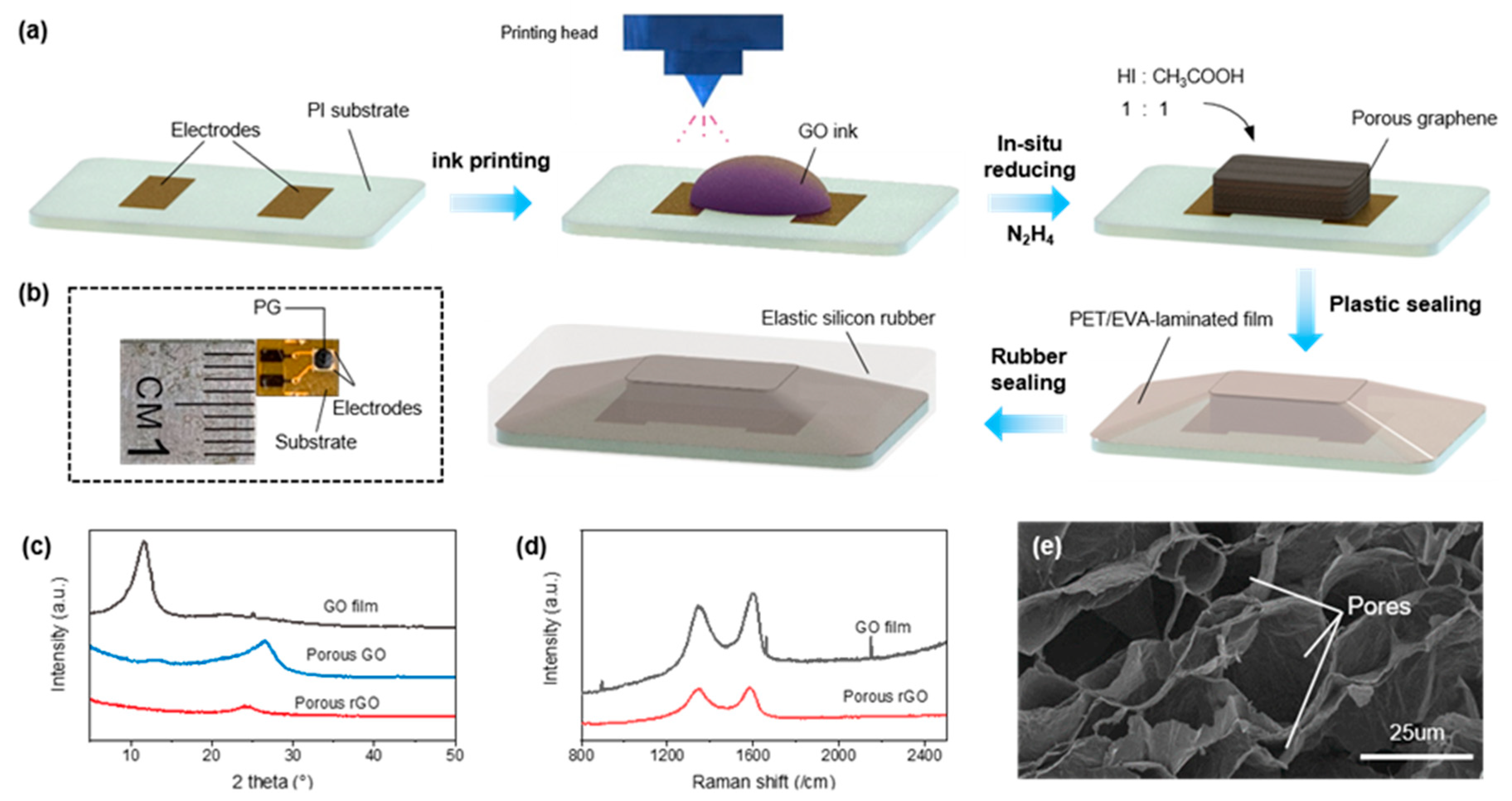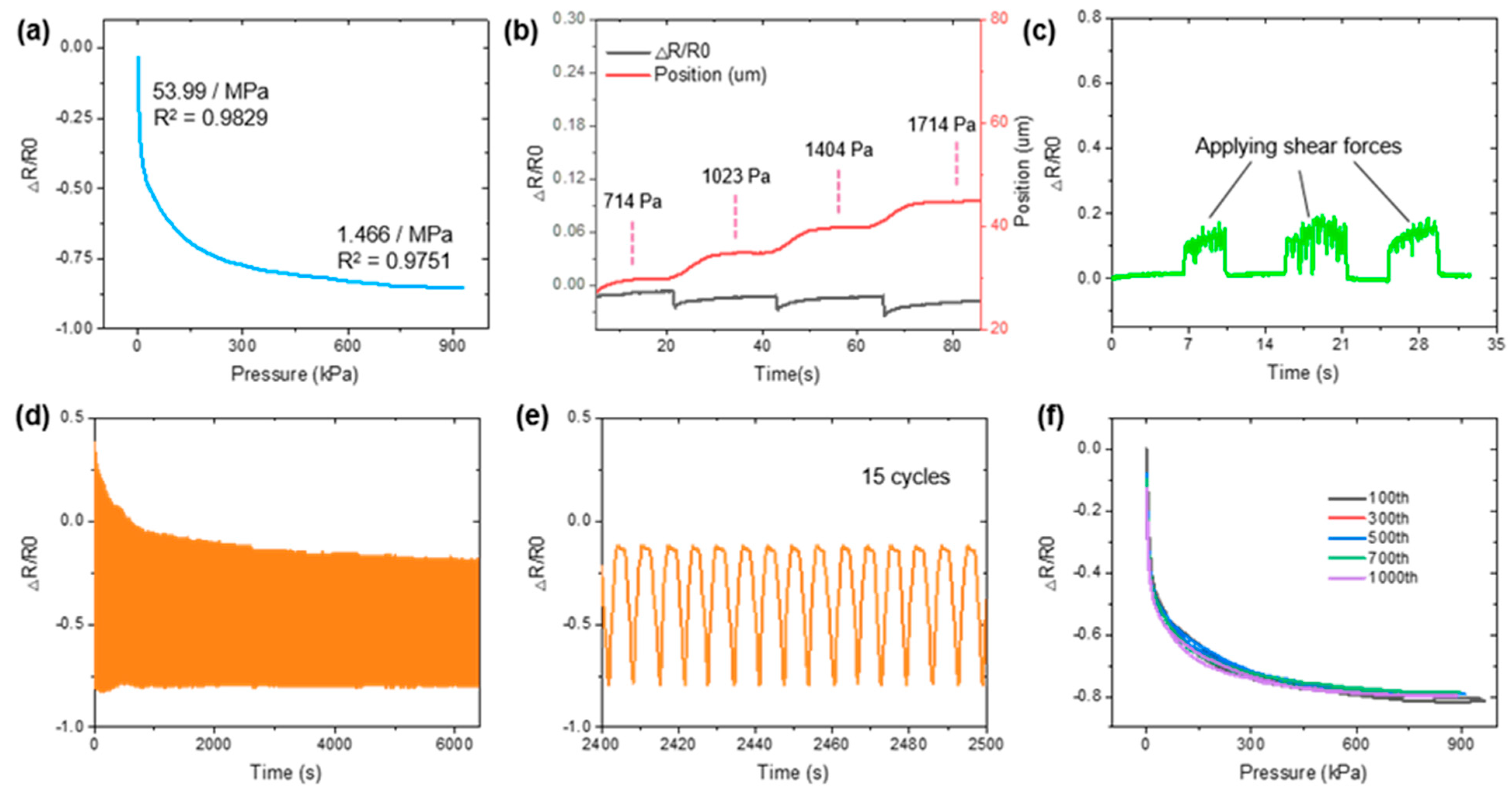A Flexible Pressure Sensor with Ink Printed Porous Graphene for Continuous Cardiovascular Status Monitoring
Abstract
1. Introduction
2. Methodology
2.1. Materials
2.2. Fabrication Procedure
2.3. Characterization
3. Experiments
3.1. Microstructure and Morphology
3.2. Pressure Sensing Property
3.3. Protection Principle
4. Cardiovascular Status Monitoring
4.1. System Establishment
4.2. Monitoring Experiments and Results
5. Conclusions
Author Contributions
Funding
Institutional Review Board Statement
Informed Consent Statement
Data Availability Statement
Conflicts of Interest
References
- Okano, T.; Izumi, S.; Katsuura, T.; Kawaguchi, H.; Yoshimoto, M. Multimodal cardiovascular information monitor using piezoelectric transducers for wearable healthcare. J. Signal Process. Syst. 2019, 91, 1053–1062. [Google Scholar] [CrossRef]
- Hao, P.P.; Jiang, F.; Cheng, J.; Ma, L.Y.; Zhang, Y.; Zhao, Y.X. Traditional Chinese medicine for cardiovascular disease evidence and potential mechanisms. J. Am. Coll. Cardiol. 2017, 69, 2952–2966. [Google Scholar] [CrossRef] [PubMed]
- Ghosh, S.; Feng, M.; Nguyen, H.; Li, J. Hypotension risk prediction via sequential contrast patterns of ICU blood pressure. IEEE J. Biomed. Health Inform. 2016, 20, 1416–1426. [Google Scholar] [CrossRef]
- Lehman, L.W.H.; Saeed, M.; Talmor, D.; Mark, R.; Malhotra, A. Methods of blood pressure measurement in the ICU. Crit. Care Med. 2013, 41, 34–40. [Google Scholar] [CrossRef]
- Atef, M.; Wang, M.; Wang, G.X. A fully integrated high-sensitivity wide dynamic range PPG sensor with an integrated photodiode and an automatic dimming control LED driver. IEEE Sens. J. 2018, 18, 652–659. [Google Scholar] [CrossRef]
- Zhang, D.Y.; Zhang, L.; Zhang, D.; Zheng, Y.P. Wavelet based analysis of Doppler ultrasonic wrist-pulse signals. Int. Conf. Biomed. 2008, 2, 539–543. [Google Scholar] [CrossRef]
- Mao, R.; Yao, W.; Qadir, A.; Chen, W.; Hu, H.J.S.; Physical, A.A. 3-D graphene aerogel sphere-based flexible sensors for healthcare applications. Sens. Actuators A Phys. 2020, 112144. [Google Scholar] [CrossRef]
- Cocciolone, A.J.; Hawes, J.Z.; Staiculescu, M.C.; Johnson, E.O.; Murshed, M.; Wagenseil, J.E. Elastin, arterial mechanics, and cardiovascular disease. Am. J. Physiol. Heart C 2018, 315, H189–H205. [Google Scholar] [CrossRef]
- Yang, J.C.; Mun, J.; Kwon, S.Y.; Park, S.; Bao, Z.N.; Park, S. Electronic skin: Recent progress and future prospects for skin-attachable devices for health monitoring, robotics, and prosthetics. Adv. Mater. 2019, 31, 1904765. [Google Scholar] [CrossRef]
- Ma, Y.J.; Zhang, Y.C.; Cai, S.S.; Han, Z.Y.; Liu, X.; Wang, F.L.; Cao, Y.; Wang, Z.H.; Li, H.F.; Chen, Y.H.; et al. Flexible hybrid electronics for digital healthcare. Adv. Mater. 2020, 32, 1902062. [Google Scholar] [CrossRef]
- Shi, W.; Guo, Y.; Liu, Y. When flexible organic field-effect transistors meet biomimetics: A prospective view of the internet of things. Adv. Mater. 2020, 32, 1901493. [Google Scholar] [CrossRef] [PubMed]
- Kim, K.; Choi, J.; Jeong, Y.; Cho, I.; Kim, M.; Kim, S.; Oh, Y.; Park, I. Highly Sensitive and Wearable Liquid Metal-Based Pressure Sensor for Health Monitoring Applications: Integration of a 3D-Printed Microbump Array with the Microchannel. Adv. Healthc. Mater. 2019, 8, 1900978. [Google Scholar] [CrossRef] [PubMed]
- Wang, L.; Dou, W.K.; Chen, J.; Lu, K.C.; Zhang, F.; Abdulaziz, M.; Su, W.G.; Li, A.Q.; Xu, C.H.; Sun, Y. A CNT-PDMS wearable device for simultaneous measurement of wrist pulse pressure and cardiac electrical activity. Mat. Sci. Eng. C Mater. 2020, 117, 111345. [Google Scholar] [CrossRef] [PubMed]
- Moghadam, B.H.; Hasanzadeh, M.; Simchi, A. Self-powered wearable piezoelectric sensors based on polymer nanofiber-metal-organic framework nanoparticle composites for arterial pulse monitoring. ACS Appl. Nano Mater. 2020, 3, 8742–8752. [Google Scholar] [CrossRef]
- Wang, D.; Wang, L.; Zheng, L.; Zheng, Y.; Wang, K.; Zhao, L.; Han, W.; Jiang, K.; Shen, G. Biomimetic, biocompatible and robust silk Fibroin-MXene film with stable 3D cross-link structure for flexible pressure sensors. Nano Energy 2020, 78, 105252. [Google Scholar] [CrossRef]
- Wu, Q.; Qiao, Y.C.; Guo, R.; Naveed, S.; Hirtz, T.; Li, X.S.; Fu, Y.X.; Wei, Y.H.; Deng, G.; Yang, Y.; et al. Triode-mimicking graphene pressure sensor with positive resistance variation for physiology and motion monitoring. ACS Nano 2020, 14, 10104–10114. [Google Scholar] [CrossRef]
- Cao, M.H.; Wang, M.Q.; Li, L.; Qiu, H.W.; Padhiar, M.A.; Yang, Z. Wearable rGO-Ag NW@cotton fiber piezoresistive sensor based on the fast charge transport channel provided by Ag nanowire. Nano Energy 2018, 50, 528–535. [Google Scholar] [CrossRef]
- Gong, S.; Yap, L.W.; Zhu, B.; Zhai, Q.; Liu, Y.; Lyu, Q.; Wang, K.; Yang, M.; Ling, Y.; Lai, D.T.H.; et al. Local crack-programmed gold nanowire electronic skin tattoos for in-plane multisensor integration. Adv. Mater. 2019, 31, 1903789. [Google Scholar] [CrossRef]
- Xie, L.P.; Chen, P.; Chen, S.; Yu, K.; Sun, H.B. Low-Cost and Highly Sensitive Wearable Sensor Based on Napkin for Health Monitoring. Sensors 2019, 19, 3427. [Google Scholar] [CrossRef]
- Li, L.; Zheng, J.H.; Chen, J.; Luo, Z.B.; Su, Y.; Tang, W.; Gao, X.; Li, Y.T.; Cao, C.J.; Liu, Q.H.; et al. Flexible Pressure Sensors for Biomedical Applications: From Ex Vivo to In Vivo. Adv. Mater. Interfaces 2020, 7, 2000743. [Google Scholar] [CrossRef]
- Yang, D.; Yang, W.; Li, L.H.; Zhou, K.; Hao, M.M.; Feng, X.Y.; Zhang, T.; Liu, Y.B. Highly Sensitive Microstructure-Based Flexible Pressure Sensor for Quantitative Evaluation of Motor Function Recovery after Spinal Cord Injury. Sensors 2019, 19, 4673. [Google Scholar] [CrossRef] [PubMed]
- Al-Handarish, Y.; Omisore, O.M.; Duan, W.K.; Chen, J.; Zebang, L.; Akinyemi, T.O.; Du, W.J.; Li, H.; Wang, L. Facile Fabrication of 3D Porous Sponges Coated with Synergistic Carbon Black/Multiwalled Carbon Nanotubes for Tactile Sensing Applications. Nanomaterials 2020, 10, 1941. [Google Scholar] [CrossRef] [PubMed]
- Jeong, Y.; Park, J.; Lee, J.; Kim, K.; Park, I. Ultrathin, Biocompatible, and Flexible Pressure Sensor with a Wide Pressure Range and Its Biomedical Application. ACS Sens. 2020, 5, 481–489. [Google Scholar] [CrossRef] [PubMed]
- Pang, K.; Song, X.; Xu, Z.; Liu, X.; Liu, Y.; Zhong, L.; Peng, Y.; Wang, J.; Zhou, J.; Meng, F.; et al. Hydroplastic foaming of graphene aerogels and artificially intelligent tactile sensors. Sci. Adv. 2020, 6, eabd4045. [Google Scholar] [CrossRef] [PubMed]
- Cheng, Y.H.; Zhou, S.B.; Hu, P.; Zhao, G.D.; Li, Y.X.; Zhang, X.H.; Han, W.B. Enhanced mechanical, thermal, and electric properties of graphene aerogels via supercritical ethanol drying and high-temperature thermal reduction. Sci. Rep. 2017, 7, 1–11. [Google Scholar] [CrossRef]
- Chun, S.; Hong, A.; Choi, Y.; Ha, C.; Park, W. A tactile sensor using a conductive graphene-sponge composite. Nanoscale 2016, 8, 9185–9192. [Google Scholar] [CrossRef]
- Peng, Y.X.; Song, X.; Pang, K.; Yang, Q.; Xu, Z.; Zhang, M.M. A flexible and stretchable bending sensor based on hydrazine-reduced porous graphene for human motion monitoring. IEEE Sens. J. 2020, 20, 12661–12670. [Google Scholar] [CrossRef]
- Kim, S.J.; Mondal, S.; Min, B.K.; Choi, C.G. Highly sensitive and flexible strain-pressure sensors with cracked paddy-shaped MoS2/graphene foam/Ecoflex hybrid nanostructures. ACS Appl. Mater. Interfaces 2018, 10, 36377–36384. [Google Scholar] [CrossRef]
- Li, M.W.; Wu, C.G.; Zhao, S.L.; Deng, T.; Wang, J.Q.; Liu, Z.W.; Wang, L.; Wang, G. Pressure sensing element based on the BN-graphene-BN heterostructure. Appl. Phys. Lett. 2018, 112, 143502. [Google Scholar] [CrossRef]
- Butnaru, I.; Serbezeanu, D.; Bruma, M.; Sava, I.; Gaan, S.; Fortunato, G. Physical and thermal properties of poly (ethylene terephthalate) fabric coated with electrospun polyimide fibers. High Perform. Polym. 2015, 27, 616–624. [Google Scholar] [CrossRef]
- Fortunato, M.; Bellagamba, I.; Tamburrano, A.; Sarto, M.S. Flexible Ecoflex®/Graphene Nanoplatelet Foams for Highly Sensitive Low-Pressure Sensors. Sensors 2020, 20, 4406. [Google Scholar] [CrossRef] [PubMed]
- Lv, B.; Chen, X.T.; Liu, C.G. A Highly Sensitive Piezoresistive Pressure Sensor Based on Graphene Oxide/Polypyrrole@Polyurethane Sponge. Sensors 2020, 20, 1219. [Google Scholar] [CrossRef] [PubMed]
- Chen, S.C.; Wang, Y.F.; Yang, L.; Karouta, F.; Sun, K. Electron-Induced Perpendicular Graphene Sheets Embedded Porous Carbon Film for Flexible Touch Sensors. Nanomicro Lett. 2020, 12, 1–13. [Google Scholar] [CrossRef]
- Dragoman, M.; Ghimpu, L.; Obreja, C.; Dinescu, A.; Plesco, I.; Dragoman, D.; Braniste, T.; Tiginyanu, I. Ultra-lightweight pressure sensor based on graphene aerogel decorated with piezoelectric nanocrystalline films. Nanotechnology 2016, 27, 475203. [Google Scholar] [CrossRef]
- Fu, Y.; Zhao, S.; Zhu, R. A wearable multifunctional pulse monitor using thermosensation-based flexible sensors. IEEE Trans. Biomed. Eng. 2019, 66, 1412–1421. [Google Scholar] [CrossRef]
- Layne, K.; Ferro, A. Traditional Chinese medicines in the management of cardiovascular diseases: A comprehensive systematic review. Br. J. Clin. Pharmacol. 2017, 83, 20–32. [Google Scholar] [CrossRef]
- Hao, P.P.; Jiang, F.; Chen, Y.G.; Yang, J.M.; Zhang, K.; Zhang, M.X.; Zhang, C.; Zhao, Y.X.; Zhang, Y. Evidence for traditional Chinese medication to treat cardiovascular disease. Nat. Rev. Cardiol. 2015, 12, 115–122. [Google Scholar] [CrossRef]
- Chen, W.; Kobayashi, T.; Ichikawa, S.; Takeuchi, Y.; Togawa, T. Continuous estimation of systolic blood pressure using the pulse arrival time and intermittent calibration. Med. Biol. Eng. Comput. 2000, 38, 569–574. [Google Scholar] [CrossRef]
- Zheng, Y.; Li, Y.; Zhou, Y.; Dai, K.; Zheng, G.; Zhang, B.; Liu, C.; Shen, C. High-Performance Wearable Strain Sensor Based on Graphene/Cotton Fabric with High Durability and Low Detection Limit. ACS Appl. Mater. Interfaces 2020, 12, 1474–1485. [Google Scholar] [CrossRef]
- Zachwieja, J.; Neyman-Bartkowiak, A.; Rabiega, A.; Wojciechowska, M.; Barabasz, M.; Anna, M.; Silska, M.; Ostalska, D. Comparison of cuff-based and cuffless continuous blood pressure measurements in children and adolescents. Clin. Exp. Hypertens. 2020, 42, 512–518. [Google Scholar] [CrossRef]






| Sensors | GF | Range | Resolution | Ref. |
|---|---|---|---|---|
| In-situ foaming PG | 53.99 MPa−1 | 1 MPa | <300 Pa | This work |
| Graphene sheets embedded porous carbon film | 130 MPa−1 | 20 kPa | <625 Pa | [33] |
| Ecoflex/graphene nanoplatelet foams | 280 MPa−1 | 10 kPa | - | [31] |
| Graphene oxide sponge | 7.9 MPa−1 | 15 kPa | 75 Pa | [32] |
| Graphene aerogel decorated with piezoelectric nanocrystalline films | 6.75 MPa−1 | 100 kPa | - | [34] |
| Triode-mimicking graphene | 710 MPa−1 | 285 k | <15 kPa | [16] |
| Material | Density | Elasticity Modulus | Shear Elasticity | Poisson Ratio | ||||
|---|---|---|---|---|---|---|---|---|
| Ex | Ey | Ez | Gxy | Gxz | Gyx | |||
| Unit | g/cm3 | MPa | MPa | MPa | MPa | MPa | MPa | MPa |
| PG | 2.24 | 10 | 10 | 0.1 | 4.49 | 0.05 | 0.05 | 0.113 |
| Rubber | 1.2 | 2.14 | 2.14 | 2.14 | 0.72 | 0.72 | 0.72 | 0.48 |
| Plastic | 1.38 | 2280 | 2280 | 2280 | 826 | 826 | 826 | 0.38 |
Publisher’s Note: MDPI stays neutral with regard to jurisdictional claims in published maps and institutional affiliations. |
© 2021 by the authors. Licensee MDPI, Basel, Switzerland. This article is an open access article distributed under the terms and conditions of the Creative Commons Attribution (CC BY) license (http://creativecommons.org/licenses/by/4.0/).
Share and Cite
Peng, Y.; Zhou, J.; Song, X.; Pang, K.; Samy, A.; Hao, Z.; Wang, J. A Flexible Pressure Sensor with Ink Printed Porous Graphene for Continuous Cardiovascular Status Monitoring. Sensors 2021, 21, 485. https://doi.org/10.3390/s21020485
Peng Y, Zhou J, Song X, Pang K, Samy A, Hao Z, Wang J. A Flexible Pressure Sensor with Ink Printed Porous Graphene for Continuous Cardiovascular Status Monitoring. Sensors. 2021; 21(2):485. https://doi.org/10.3390/s21020485
Chicago/Turabian StylePeng, Yuxin, Jingzhi Zhou, Xian Song, Kai Pang, Akram Samy, Zengming Hao, and Jian Wang. 2021. "A Flexible Pressure Sensor with Ink Printed Porous Graphene for Continuous Cardiovascular Status Monitoring" Sensors 21, no. 2: 485. https://doi.org/10.3390/s21020485
APA StylePeng, Y., Zhou, J., Song, X., Pang, K., Samy, A., Hao, Z., & Wang, J. (2021). A Flexible Pressure Sensor with Ink Printed Porous Graphene for Continuous Cardiovascular Status Monitoring. Sensors, 21(2), 485. https://doi.org/10.3390/s21020485






